Legendary dancer and film actress Louise Brooks (1906-1985) set the trend of the bobbed haircut and personified the 'flapper', the rebellious young woman of the 1920s. Brooks played the lead in three European silent film classics: Die Büchse der Pandora/Pandora's Box (1929), Tagebuch einer Verlorenen/Diary of a Lost Girl (1929), and Prix de Beauté/Miss Europe (1930). The third film was directed by Augusto Genina, one of the most cosmopolitan directors of Italian film history. At Il Cinema Ritrovato, the programme Augusto Genina: an Italian in Europe is dedicated to him. Genina's work in cinema began in the early 1910s, and he worked in both France and Germany - often creating portraits of mischievous women...
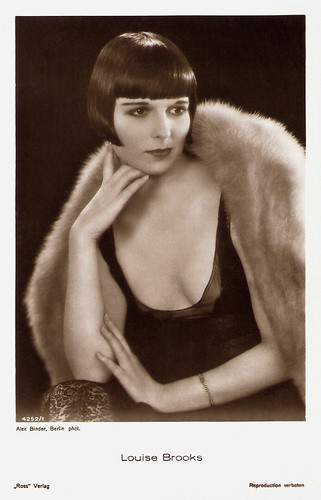
German postcard by Ross Verlag, no. 4252/1, 1929-1930. Photo: Alex Binder, Berlin.
Mary Louise Brooks was born in the Midwestern town of Cherryvale, Kansas, in 1906. She was the daughter of Leonard Porter Brooks, a lawyer, who was usually too busy with his practice to discipline his children, and Myra Rude. Rude was a talented pianist who played the latest Debussy and Ravel for her children, inspiring them with a love of books and music.
None of this protected her nine-year old daughter Louise from sexual abuse at the hands of a neighbourhood predator. This event had a major influence on Brooks' life and career.
Brooks began her entertainment career as a dancer, joining the Denishawn modern dance company in Los Angeles (whose members included Ruth St. Denis, Ted Shawn and Martha Graham) in 1922. St. Denis abruptly fired Brooks from the troupe in 1924.
Brooks became a chorus girl in George White's Scandals, followed by an appearance as a featured dancer in the 1925 edition of the Ziegfeld Follies on Broadway.
As a result of her work in the Follies, she came to the attention of Paramount Pictures producer Walter Wanger, who signed her to a five-year contract with the studio in 1925. Brooks made her screen debut in an uncredited role in the silent The Street of Forgotten Men (Herbert Brenon, 1925).
Over the next few years, she played the female lead in silent light comedies and flapper films, like It's the Old Army Game (Eddie Sutherland, 1926) opposite W. C. Fields.

French postcard by Europe, no. 599. Photo: Néro Film.
Louise Brooks was noticed in Europe for her pivotal vamp role in the buddy film A Girl in Every Port (Howard Hawks, 1928). That year, she also made the early sound film drama Beggars of Life (William Wellman, 1928). Brooks played an abused country girl on the run who meets two hoboes (Richard Arlen and Wallace Beery).
By this time in her life, she was mixing with the rich and famous, and was a regular guest of William Randolph Hearst and his mistress, Marion Davies, at San Simeon. Her distinctive bob haircut helped start a trend; many women styled their hair in imitation of her and fellow film star Colleen Moore.
Soon after Beggars Of Life, Brooks refused to stay on at Paramount after being denied a promised raise. She left for Europe to make films for G. W. Pabst, the prominent Austrian Expressionist director. In Germany, she starred as Lulu in Die Büchse der Pandora/Pandora's Box (Georg Wilhelm Pabst, 1929). The film is based on two plays by Frank Wedekind (Erdgeist and Die Büchse der Pandora) and Brooks plays the central figure. This film is notable for its frank treatment of modern sexual mores, including one of the first screen portrayals of a lesbian.
Brooks then starred in Pabst’s controversial social drama Tagebuch einer Verlorenen/Diary of a Lost Girl (Georg Wilhelm Pabst, 1929), based on the book by Margarete Böhme. In France she filmed Prix de Beauté/Miss Europe (Augusto Genina, 1930).
Hal Erickson at AllMovie: “Her haunting, provocative performances in Pabst's Pandora's Box (1928) and Diary of a Lost Girl (1929) not only established her as a screen personality of the first rank, but also fostered a Louise Brooks ‘cult’ which continued to flourish. (...) Not as highly regarded as Louise Brooks' German films for G. W. Pabst, Prix de Beauté nonetheless succeeds in terms of visual dynamics and the naturalness of the star's performance.”

Dutch collectors card in the series 'Filmsterren: een portret' by Edito Service, 1995. Photo: Stars-Films. Publicity still for Die Büchse der Pandora/Pandora's Box (G.W. Pabst, 1929).

Cover of De Film, 20 April 1930. De Film was a Belgium film magazine.
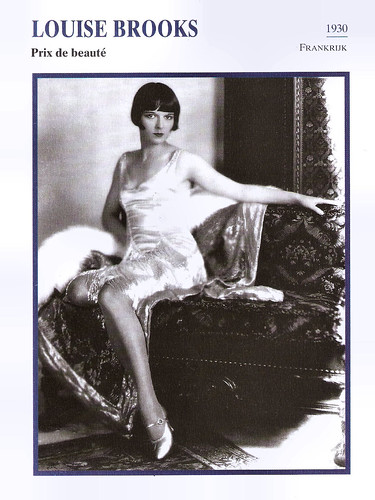
Dutch collectors card in the series 'Filmsterren: een portret' by Edito Service, 1995. Photo: Stars-Films. Publicity still for Prix de Beauté (Augusto Genina, 1930).
When Louise Brooks returned to Hollywood in 1931, she was cast in two mainstream films: God's Gift to Women (Michael Curtiz, 1931) and It Pays to Advertise (Frank Tuttle, 1931). Her performances in these films, however, were largely ignored, and few other job offers were forthcoming. She turned down the female lead opposite James Cagney in Public Enemy (William Wellman, 1931) which marked the end of her film career.
Furthermore she was only cast in bit parts and roles in B pictures and short films. At 32, Brooks retired from the screen after completing one last film, the John Wayne western Overland Stage Raiders (George Sherman, 1938). She then briefly returned to Wichita, where she was raised. After an unsuccessful attempt at operating a dance studio, she returned East and, after brief stints as a radio actor and a gossip columnist, worked as a salesgirl in a Saks Fifth Avenue store in New York City for a few years, then eked out a living as a courtesan with a few select wealthy men as clients.
In the early 1950s French film historians rediscovered her films, proclaiming her as an actress who surpassed even Marlene Dietrich and Greta Garbo as a film icon, much to her amusement. It rehabilitated her reputation in the US. With the help of James Card, film curator for the George Eastman House, she became a writer of well-researched and well-balanced articles on film history. She published her witty, extremely candid autobiography, Lulu in Hollywood, in 1982.
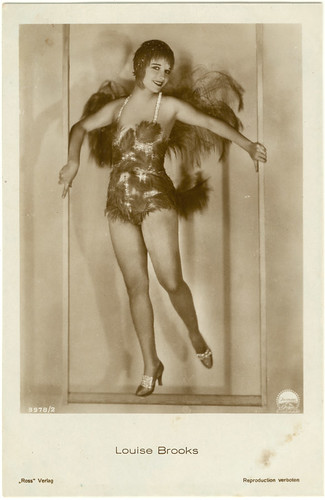
German postcard by Ross Verlag, no. 3978/2, 1928-1929. Photo: Paramount. Publicity still for The Canary Murder Case (Malcolm St. Clair, 1929). Collection: Rescued by Rover@Flickr.
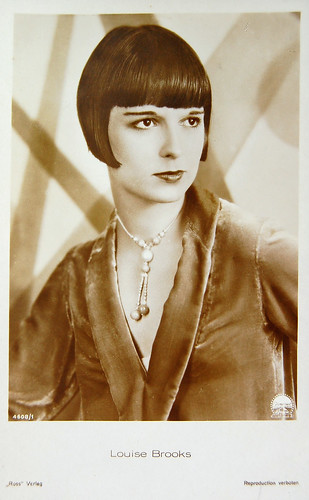
German postcard by Ross Verlag, no. 4608/1, 1929-1930. Photo: Paramount. Collection: Anni Raasu (Shme@Flickr).
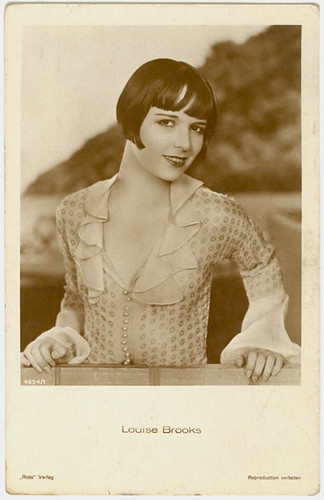
German postcard by Ross Verlag, no. 4954/1, 1929-1930. Collection: Rescued by Rover@Flickr.
Louise Brooks was married twice. In 1926, she had married director Eddie Sutherland, but they divorced in 1928 because of her relationship with George Preston Marshall, owner of a chain of laundries and future owner of the Washington Redskins football team.
In 1933, she married Chicago millionaire Deering Davis, but abruptly left him after only five months of marriage. The couple officially divorced in 1938.
Brooks enjoyed fostering speculation about her sexuality, cultivating friendships with lesbian and bisexual women, but eschewing relationships.
In 1985, Louise Brooks was found dead of a heart attack in her home in Rochester. She was 78 years old, and had appeared in only 25 films.
Scene from Die Büchse der Pandora/Pandora's Box (1929). Lulu dances with Countess Augusta Geschwitz (Alice Roberts), one of cinema's earliest representations of lesbian desire. Source: ButchInProgress (YouTube).
Scene from Prix de Beauté/Miss Europe (1930). Source: Mark Satchwell (YouTube).
Sources: Hal Erickson (AllMovie), Denny Jackson (IMDb), Wikipedia, and IMDb.

German postcard by Ross Verlag, no. 4252/1, 1929-1930. Photo: Alex Binder, Berlin.
Paramount
Mary Louise Brooks was born in the Midwestern town of Cherryvale, Kansas, in 1906. She was the daughter of Leonard Porter Brooks, a lawyer, who was usually too busy with his practice to discipline his children, and Myra Rude. Rude was a talented pianist who played the latest Debussy and Ravel for her children, inspiring them with a love of books and music.
None of this protected her nine-year old daughter Louise from sexual abuse at the hands of a neighbourhood predator. This event had a major influence on Brooks' life and career.
Brooks began her entertainment career as a dancer, joining the Denishawn modern dance company in Los Angeles (whose members included Ruth St. Denis, Ted Shawn and Martha Graham) in 1922. St. Denis abruptly fired Brooks from the troupe in 1924.
Brooks became a chorus girl in George White's Scandals, followed by an appearance as a featured dancer in the 1925 edition of the Ziegfeld Follies on Broadway.
As a result of her work in the Follies, she came to the attention of Paramount Pictures producer Walter Wanger, who signed her to a five-year contract with the studio in 1925. Brooks made her screen debut in an uncredited role in the silent The Street of Forgotten Men (Herbert Brenon, 1925).
Over the next few years, she played the female lead in silent light comedies and flapper films, like It's the Old Army Game (Eddie Sutherland, 1926) opposite W. C. Fields.

French postcard by Europe, no. 599. Photo: Néro Film.
Haunting, Provocative Performances
Louise Brooks was noticed in Europe for her pivotal vamp role in the buddy film A Girl in Every Port (Howard Hawks, 1928). That year, she also made the early sound film drama Beggars of Life (William Wellman, 1928). Brooks played an abused country girl on the run who meets two hoboes (Richard Arlen and Wallace Beery).
By this time in her life, she was mixing with the rich and famous, and was a regular guest of William Randolph Hearst and his mistress, Marion Davies, at San Simeon. Her distinctive bob haircut helped start a trend; many women styled their hair in imitation of her and fellow film star Colleen Moore.
Soon after Beggars Of Life, Brooks refused to stay on at Paramount after being denied a promised raise. She left for Europe to make films for G. W. Pabst, the prominent Austrian Expressionist director. In Germany, she starred as Lulu in Die Büchse der Pandora/Pandora's Box (Georg Wilhelm Pabst, 1929). The film is based on two plays by Frank Wedekind (Erdgeist and Die Büchse der Pandora) and Brooks plays the central figure. This film is notable for its frank treatment of modern sexual mores, including one of the first screen portrayals of a lesbian.
Brooks then starred in Pabst’s controversial social drama Tagebuch einer Verlorenen/Diary of a Lost Girl (Georg Wilhelm Pabst, 1929), based on the book by Margarete Böhme. In France she filmed Prix de Beauté/Miss Europe (Augusto Genina, 1930).
Hal Erickson at AllMovie: “Her haunting, provocative performances in Pabst's Pandora's Box (1928) and Diary of a Lost Girl (1929) not only established her as a screen personality of the first rank, but also fostered a Louise Brooks ‘cult’ which continued to flourish. (...) Not as highly regarded as Louise Brooks' German films for G. W. Pabst, Prix de Beauté nonetheless succeeds in terms of visual dynamics and the naturalness of the star's performance.”

Dutch collectors card in the series 'Filmsterren: een portret' by Edito Service, 1995. Photo: Stars-Films. Publicity still for Die Büchse der Pandora/Pandora's Box (G.W. Pabst, 1929).

Cover of De Film, 20 April 1930. De Film was a Belgium film magazine.

Dutch collectors card in the series 'Filmsterren: een portret' by Edito Service, 1995. Photo: Stars-Films. Publicity still for Prix de Beauté (Augusto Genina, 1930).
Lulu in Hollywood
When Louise Brooks returned to Hollywood in 1931, she was cast in two mainstream films: God's Gift to Women (Michael Curtiz, 1931) and It Pays to Advertise (Frank Tuttle, 1931). Her performances in these films, however, were largely ignored, and few other job offers were forthcoming. She turned down the female lead opposite James Cagney in Public Enemy (William Wellman, 1931) which marked the end of her film career.
Furthermore she was only cast in bit parts and roles in B pictures and short films. At 32, Brooks retired from the screen after completing one last film, the John Wayne western Overland Stage Raiders (George Sherman, 1938). She then briefly returned to Wichita, where she was raised. After an unsuccessful attempt at operating a dance studio, she returned East and, after brief stints as a radio actor and a gossip columnist, worked as a salesgirl in a Saks Fifth Avenue store in New York City for a few years, then eked out a living as a courtesan with a few select wealthy men as clients.
In the early 1950s French film historians rediscovered her films, proclaiming her as an actress who surpassed even Marlene Dietrich and Greta Garbo as a film icon, much to her amusement. It rehabilitated her reputation in the US. With the help of James Card, film curator for the George Eastman House, she became a writer of well-researched and well-balanced articles on film history. She published her witty, extremely candid autobiography, Lulu in Hollywood, in 1982.

German postcard by Ross Verlag, no. 3978/2, 1928-1929. Photo: Paramount. Publicity still for The Canary Murder Case (Malcolm St. Clair, 1929). Collection: Rescued by Rover@Flickr.

German postcard by Ross Verlag, no. 4608/1, 1929-1930. Photo: Paramount. Collection: Anni Raasu (Shme@Flickr).

German postcard by Ross Verlag, no. 4954/1, 1929-1930. Collection: Rescued by Rover@Flickr.
Speculation
Louise Brooks was married twice. In 1926, she had married director Eddie Sutherland, but they divorced in 1928 because of her relationship with George Preston Marshall, owner of a chain of laundries and future owner of the Washington Redskins football team.
In 1933, she married Chicago millionaire Deering Davis, but abruptly left him after only five months of marriage. The couple officially divorced in 1938.
Brooks enjoyed fostering speculation about her sexuality, cultivating friendships with lesbian and bisexual women, but eschewing relationships.
In 1985, Louise Brooks was found dead of a heart attack in her home in Rochester. She was 78 years old, and had appeared in only 25 films.
Scene from Die Büchse der Pandora/Pandora's Box (1929). Lulu dances with Countess Augusta Geschwitz (Alice Roberts), one of cinema's earliest representations of lesbian desire. Source: ButchInProgress (YouTube).
Scene from Prix de Beauté/Miss Europe (1930). Source: Mark Satchwell (YouTube).
Sources: Hal Erickson (AllMovie), Denny Jackson (IMDb), Wikipedia, and IMDb.
No comments:
Post a Comment